|
|
|
Sort Order |
|
|
|
Items / Page
|
|
|
|
|
|
|
| Srl | Item |
| 1 |
ID:
088499
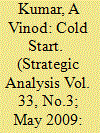

|
|
|
| 2 |
ID:
088518
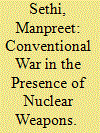

|
|
|
|
|
| Publication |
2009.
|
| Summary/Abstract |
Nuclear weapons cannot obviate wars, but can change its complexion and influence the manner of its conduct. In order to keep nuclear weapons from entering into real warfare, it is important to intelligently judge an adversary's nuclear thresholds and to calibrate one's own conventional strikes. For India, the exploration of this space is particularly important in order to deny Pakistan a free hand to indulge in sub-conventional conflict even as it holds the threat of an all-out nuclear war against an Indian conventional response. This article examines the Indian experience in this regard on the basis of Kargil, 1999. It concludes that limited war - with precise, clearly articulated objectives, calibrated use of military force, and astute use of politico-diplomatic space - offers scope for conduct of conventional war in the presence of nuclear weapons.
|
|
|
|
|
|
|
|
|
|
|
|
|
|
|
|
| 3 |
ID:
088511
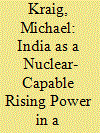

|
|
|
|
|
| Publication |
2009.
|
| Summary/Abstract |
The two global trends of multipolarity (rising powers) and non-polarity (failing states) are strongly present in the South Asian geopolitical context. India's competitive-cooperative relationship with China is clearly part of the multipolar trend of rising powers throughout the world, while India's long, antagonistic history with Pakistan is increasingly witness to a weakening and radicalized Pakistani state. In this mixed strategic environment, Indian nuclear weapons are neither a global bane nor a coercive form of power for compelling a lopsided agreement with Pakistan on Kashmir. Indeed, the greatest indirect challenge to South Asian stability is not Indian nuclear capabilities, but rather US grand strategy, which helps fuel centrifugal forces in Pakistan while potentially increasing the bellicosity of other powers such as Russia and China, with potentially negative long-term effects on the currently minimalist Indian nuclear policy.
|
|
|
|
|
|
|
|
|
|
|
|
|
|
|
|
| 4 |
ID:
088498
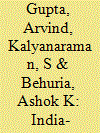

|
|
|
|
|
| Publication |
2009.
|
| Summary/Abstract |
India-Pakistan relations have been on a roller coaster. They reached a new low after
the Mumbai terror attacks of November 26, 2008. Tensions increased to such an
extent that the possibility of a war was openly talked about on both sides. However,
only a couple of hours before the attacks, the foreign ministers of the two countries
had appeared upbeat about the state of the peace process and the composite dialogue
which had started in January 2004.
The post-Mumbai situation brings to mind the Kargil episode of May 1999. A few
months before units of Pakistan's Northern Light Infanty were discovered in the icy
heights of Kargil, India and Pakistan were enjoying the honeymoon that had begun
with Prime Minister Vajpayee's visit to Lahore. Vajpayee's visit to Lahore, also
known as the Lahore Bus Yatra, was an attempt by the two sides to normalize the
bilateral relationship after the May 1998 nuclear weapons tests. Even as the Prime
Ministers of India and Pakistan were signing documents to normalize the relationship,
the Pakistan Army was planning intrusions into Indian territory. After the Pakistan
Army was forced to withdraw from the Kargil heights by Indian military operations
and international condemnation and pressure, the elected civilian government was
overthrown by the then Army Chief, General Parvez Musharraf, who ruled the
country for the next nine years.
|
|
|
|
|
|
|
|
|
|
|
|
|
|
|
|
| 5 |
ID:
088517


|
|
|
|
|
| Publication |
2009.
|
| Summary/Abstract |
Although the broad contours of India's nuclear doctrine were announced within the days of May 1998 nuclear tests, the formal doctrine was made public only five years later. This article will critically examine the evolution of India's nuclear doctrine in terms of the 1999 Kargil conflict and the 2001-2002 military confrontation with Pakistan. This article concludes that the one-page nuclear doctrine of 2003 remains sketchy and subject to varied interpretations. It would therefore be best to formally update or elaborate upon the nuclear doctrine, keeping in view key issues such as India's development of a Ballistic Missile Defence system
|
|
|
|
|
|
|
|
|
|
|
|
|
|
|
|
| 6 |
ID:
088501
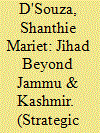

|
|
|
| 7 |
ID:
088506


|
|
|
|
|
| Publication |
2009.
|
| Summary/Abstract |
In May 1998, India and Pakistan surprised the world by carrying out nuclear weapon tests. The tests were followed by two developments. The positive development was Lahore Summit in February 1999. In a simultaneous negative development, Pakistan initiated the Kargil war. Due to difficult terrain, inadequate intelligence and poor surveillance, it took time to clear the initial fog of war. Later, despite a self-imposed strategy, Indian forces responded with a resolve and daring that few believed was possible. The conflict terminated in a resounding politico-military triumph for India and a humiliating setback for Pakistan. The author reflects on the war, its geo-political impact and the follow up on its key lessons.
|
|
|
|
|
|
|
|
|
|
|
|
|
|
|
|
| 8 |
ID:
088508


|
|
|
|
|
| Publication |
2009.
|
| Summary/Abstract |
Ten years later, the Kargil War still arouses deep emotions turning around Pakistan's gross perfidy, an intelligence failure, great heroism, military improvisation and innovation, a national upsurge, a most open inquiry leading to a comprehensive review of vital issues long closed to scrutiny and reform. Its report, prepared in record time, was uniquely presented to the nation as a commercial publication. (From Surprise to Reckoning: The Kargil Review Committee Report, Sage, New Delhi, December 1999.)
|
|
|
|
|
|
|
|
|
|
|
|
|
|
|
|
| 9 |
ID:
088502
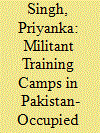

|
|
|
|
|
| Publication |
2009.
|
| Summary/Abstract |
Investigations into Mumbai's 26/11 attack made startling revelations about the militant
training camps in Pakistan-occupied Kashmir (PoK). The Mumbai perpetrators
started from Baitul-Mujahideen in Muzaffarabad, the capital of the so-called 'Azad
Kashmir', and headed for Mumbai via Karachi. They underwent specialized training
in PoK for an extended period before the attack.
Over the years, PoK has become a safe haven not only for terrorists operating in
Kashmir but also for those linked with international terror outfits like Al Qaeda. At
least 55 training camps are said to be located in the region and their cadres number
close to 5,000. The proximity of these camps to Kashmir and the terrain of the region
make infiltration much more convenient especially during summers. Muzaffarabad
and Kotli are known epicentres of such camps and dreaded militant organizations
such as Lashkar-e-Toiba (LeT) and Hizbul Mujahideen have their operational
headquarters there. Terrorist camps are noted to be widespread in Bhimber, Bakryal,
Balakot, Chawari, Kotli, and Mangla. Lashkar has two camps in Muzaffarabad -
Abdul-Bin-Masud and Danna. Hizbul has one in Muzaffarabad and the other in
Mangla. Jaish-e-Mohammed also has a strong foothold in the region even though it
operates chiefly from Balakot (North West Frontier Province).
|
|
|
|
|
|
|
|
|
|
|
|
|
|
|
|
| 10 |
ID:
088503
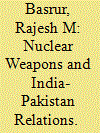

|
|
|
|
|
| Publication |
2009.
|
| Summary/Abstract |
India-Pakistan relations are best understood as an example of nuclear rivalry, in which nuclear weapons both exacerbate and limit hostility. In all such relationships, the minimal possession of nuclear weapons suffices to deter. Both India and Pakistan have adopted a minimalist posture, yet their strategic thinking tends to be inconsistent, which makes them vulnerable to needless expansion. This essay points to the conceptual basis for an optimal doctrine. It concludes that, while the military equation between India and Pakistan is stable, India has begun to widen the political gap between them.
|
|
|
|
|
|
|
|
|
|
|
|
|
|
|
|
| 11 |
ID:
088504
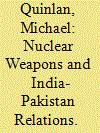

|
|
|
|
|
| Publication |
2009.
|
| Summary/Abstract |
Nuclear weapons deter by the possibility of their use, and in no other way. Although US and Soviet arsenals became grotesquely excessive in both numbers and diversity in the late 1960s, by the later 1908s there had been very extensive reductions in both numbers and types. NATO's collective doctrine had accepted that the only sen-sible role for its nuclear weapons was for war-termination. Western governments had increasingly accepted the idea of sufficiency, recognizing that notions of nuclear supe-riority were vacuous. NATO, having abandoned as too precarious a strategy of 'mas-sive retaliation', switched to a concept of 'flexible response'. The total dismissal of the conceptual framework Western nuclear policies of past years runs a genuine risk of over-confidence or even complacency.
|
|
|
|
|
|
|
|
|
|
|
|
|
|
|
|
| 12 |
ID:
088500


|
|
|
|
|
| Publication |
2009.
|
| Summary/Abstract |
The November 2008 Mumbai terror attacks that shook the world again had
tangible links to the security and intelligence establishment of Pakistan. The
emergent situation is forcing the policy-making community to take appropriate
action so that the culprits are brought to justice and the elements sponsoring
the terror attacks in India are adequately deterred. Several options were being
exercised and explored for the purpose. As the Pakistani Government is undertaking
only cosmetic and deceptive steps to ward off international pressure, the
world and India appear far from convinced. Quite obviously, this puts pressure on
the Indian strategic and policy-making communities to consider the option of war.
Based on the Cold War experience, the international community and even analysts
in strategic studies assume that a conventional war between two nuclear armed
countries or groups is impossible. It is propounded that any conflict between two
nuclear entities will either immediately or subsequently escalate into a nuclear war. Is
this true? Reality falsifies this hypothesis, which is essentially based on limited
historical experience and erroneous logic.
|
|
|
|
|
|
|
|
|
|
|
|
|
|
|
|
| 13 |
ID:
088520


|
|
|
|
|
| Publication |
2009.
|
| Summary/Abstract |
In Lahore, in 1999, Pakistan dropped its 'Kashmir first' approach and agreed to discuss it with India along with other issues. Later, under Musharraf, there was an offer to move beyond UN resolutions and adopt a four-step approach to resolve the Kashmir issue. Musharraf's proposals were taken seriously and widely hailed as a sign of flexibility and pragmatism from the Pakistani side. This paper critically analyses these approaches since Lahore and argues that they were occasioned by the changing global political context and that they were more apparent than real. At the official level, there is hardly any departure from the core stance of Pakistan on Kashmir. The civilian government in Pakistan today has retained the process of dialogue initiated by Musharraf but is yet to spell out its approach to Kashmir. The paper argues that even if there is a realization that the policy of subversion and militancy has backfired, the temptation to retain jihadis as the last option will continue to play havoc with the process of dialogue aimed at finding a solution to Kashmir in the days to come.
|
|
|
|
|
|
|
|
|
|
|
|
|
|
|
|
| 14 |
ID:
088519
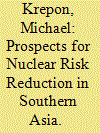

|
|
|
|
|
| Publication |
2009.
|
| Summary/Abstract |
The earliest years of offsetting nuclear weapon capabilities between rivals can be the most harrowing. India and Pakistan have certainly followed this pattern. But over time, rivals can moderate their competition, especially with regard to nuclear weapons. Formal arms control treaties, like those negotiated between the United States and the Soviet Union, are unlikely for southern Asia. India and Pakistan can, however, employ tacit agreements, confidence-building, and nuclear risk-reduction measures to allay mutual concerns over nuclear weapons. Forward progress on this agenda will likely be constrained by extremist acts linked to Pakistan and political instability there.
|
|
|
|
|
|
|
|
|
|
|
|
|
|
|
|
| 15 |
ID:
088509


|
|
|
|
|
| Publication |
2009.
|
| Summary/Abstract |
The Kargil conflict can be categorized as a 'limited war'. It was initiated by Pakistan to achieve mixed military and political objectives, but made important misjudgments that doomed the enterprise to failure. The questions discussed in this article are: why was India surprised; why did both countries observe such great restraint; did the Kargil conflict have a nuclear dimension; and is 'limited war' a viable concept with nuclear deterrence obtaining in South Asia. It also argues that the Kargil conflict was an exception, in some dimensions, to the 'stability-instability paradox'.
|
|
|
|
|
|
|
|
|
|
|
|
|
|
|
|
| 16 |
ID:
088505


|
|
|
| 17 |
ID:
088516


|
|
|
|
|
| Publication |
2009.
|
| Summary/Abstract |
The tenth anniversary of India and Pakistan's 1998 nuclear tests enables scholars to revisit the issue of South Asian proliferation with a decade of hindsight. I argue that nuclear weapons have had two destabilizing effects. First, nuclear weapons' ability to shield Pakistan against all-out Indian retaliation, and to attract international attention to Pakistan's dispute with India, encouraged aggressive Pakistani behavior. This provoked forceful Indian responses, ranging from large-scale mobilization to limited war. Second, these Indo-Pakistani crises led India to adopt a more aggressive military posture toward Pakistan. This could exacerbate security-dilemma dynamics and increase the likelihood of future Indo-Pakistani conflict.
|
|
|
|
|
|
|
|
|
|
|
|
|
|
|
|
| 18 |
ID:
088515
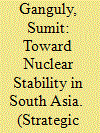

|
|
|
|
|
| Publication |
2009.
|
| Summary/Abstract |
Contrary to the arguments of proliferation pessimists, this article contends that the overt nuclearization of South Asia has contributed to stability in the region. To that end this article carefully examines two recent crises in Indo-Pakistani relations and concludes that in the absence of nuclear weapons they would have culminated in full-scale war. Accordingly, while Indo-Pakistani relations may remain fraught with tension, the likelihood of major war in the region has dramatically diminished.
|
|
|
|
|
|
|
|
|
|
|
|
|
|
|
|
|
|
|
|
|